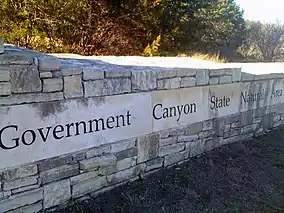Government Canyon State Natural Area
First opened to the public in October, 2005, Government Canyon State Natural Area (GCSNA) preserves 12,244 acres (49.5 km2; 19.1 sq mi) of rugged hills and canyons typical of the Texas Hill Country. It is designated a Natural Area, rather than a State Park, and therefore the primary focus is maintenance and protection of the property's natural state. Accordingly, access and recreational activities may be restricted if the Texas Parks & Wildlife Department (TPWD) deems such action necessary to protect the environment.
| Government Canyon State Natural Area | |
|---|---|
 | |
| Location | Bexar County, Texas, United States |
| Coordinates | 29.548°N 98.765°W |
| Area | 12,244 acres (49.55 km2) |
| Established | 1993 |
| Governing body | Texas Parks and Wildlife Department |
| Website | Government State Natural Area |
The reserve is located in northwestern Bexar County, and protects a large, relatively pristine tract of Hill Country terrain, numerous and diverse species of plants & wildlife, the upper Culebra Creek/Leon Creek watershed, and a critical aquifer recharge zone for the San Antonio Water System.
In September, 2009, the City of San Antonio transferred 3,000 acres (12 km2) of land to the TPWD for inclusion in the Natural Area, specifically to support long-term protection of the Edwards Aquifer, and thereby increasing the total acreage within the reserve from 8,783 acres (35.54 km2) to 11,783 acres (47.68 km2). Most recently, in April, 2013, an additional 461 acres (1.87 km2) were added to GCSNA through a combination of funding from the City of San Antonio, Texas Parks & Wildlife, and a US Fish & Wildlife Service endangered species grant, which brought the reserve's total area to 12,244 acres (49.55 km2).
Fauna
Among the many bird species present, GCSNA includes nesting habitats of the golden-cheeked warbler and the black-capped vireo, both of which are classified as endangered. As in much of the Hill Country, white-tailed deer (Odocoileus virginianus) are by far the most common large mammal on the property. Additionally, wild turkeys, armadillos, skunks, raccoons, opossums, cottontail rabbits, jack rabbits, and fox squirrels are present. Feral pigs, exotic axis deer, porcupines, rock squirrels, and ringtailed cats may occasionally be encountered. Bobcats, coyotes, both red and grey foxes, and rarely, mountain lions, also inhabit the area, but are seldom seen by visitors.
Flora
Primary vegetation includes the Ashe juniper, commonly known as "mountain cedar", several different species of oak, also sycamore, mesquite, persimmon, mountain laurel, Texas madrone, redbud, maple, hackberry, cedar elm, mulberry, wild grape, several different types of brush, prickly pear, yucca, sotol, and various grasses. A more extensive list of the fauna and flora present in the park can be found at the GCSNA Ranger Station.
Visitors
GCSNA is open to the public 4 days (Fri. – Mon.) each week, weather permitting, and offers 40 miles (64 km) of hiking/biking trails,[1] with over 500 feet (150 m) of elevation change found within the reserve's boundaries. Entrance fee: $6 per adult; children 12 and under, free. Beginning Friday, October 5, 2012 the Natural Area will allow overnight camping on Fridays and Saturdays in the "Front Country" section only. There are regular walk-in 50–60 yards (46–55 m) campsites, and two group walk-in campsites that allow up to 16 persons per site.
TPWD urges all visitors to respect the LEAVE NO TRACE set of wilderness ethics when visiting the Natural Area: 1) Plan Ahead and Prepare, 2) Travel on Marked Trails Only, 3) Always Dispose of Waste Properly, 4) Leave Behind What You Find, 5) Never Build An Open Fire, 6) Respect All Wildlife, and 7) Be Considerate of Other Visitors.
References
- "Texas Trails Network: Government Canyon State Natural Area (ID: 832)". Archived from the original on 2011-07-28. Retrieved 2010-01-25.
Other sources
- Texas Parks & Wildlife: City of San Antonio Transfers Almost 3,000 Acres to Government Canyon
- My San Antonio: City gives 3,000 acres of Government Canyon to state
- Leon Springs Business Association: City land to go to Government Canyon
- My San Antonio: City earns praise for land transfer
- My San Antonio: 461 more acres for Government Canyon
External links
| Wikimedia Commons has media related to Government Canyon State Natural Area. |
